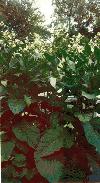| Plant Photo |
Scientific Name |
Common Name and Description |
Seed Photo |
 |
Capsicum annuum |
Common Name: Chile Pepper or Cayenne Pepper
Leaves: Alternate, ovate to elliptic-lanceolate or lanceolate, acute to acuminate to 6 cm long and 3 cm wide
Flowers: Corolla stellate, whitish, about 7 mm wide
Fruit: Berry is ovoid to nearly globose, persistent, red or yellowish, to about 15 mm long pungently aromatic
Habitat: On ledges along rivers, in thickets, groves and along arroyos
Range: Edwards Plateau to south Texas; east to Florida and west to Arizona; throughout tropical America
Group: Dicot
Family: Solanaceae
Growth Habit: Subshurb/Shrub/Forb/Herb - slender divergent brittle green branches to 3 m high
Duration: Annual/Perennial
U.S. Nativity: Native/Introduced |
 |
 |
Datura stramonium |
Common Name: Jimsonweed, Jamestown Weed or Datura
Leaves: Ovate to elliptic, to 2 dm long sinuately to lanciniately lobed
Flowers: Calyx 35-45 mm long the unequeal teeth 5-10 mm long, corolla white, commonly timged with lavender, 6-8 cm long
Fruit: Capsule erect, ovaoid 3.5-5 cm long usually armed with spines mostly less than 5 mm long finely and sparsely puberulent to glabrate; seeds black, rugulose and finely pitted
Habitat: In cultivated areas and waste places throughout Texas; widely distributed through the world
Range: United States except Alaska and Wyoming
Group: Dicot
Family: Solancacea
Growth Habit: Forb/Herb/Subshrub - simple to spreading branched erect to 15 dm high, with green sparsely puberulent to glabrate stems and foliage
Duration: Annual
U.S. Nativity: Introduced |
 |
 |
Solanum lycopersicum formerly Lycopersicon esculentus |
Common Name: Tomato
Leaves: Odd-pinnate, with small interstitial petiolulate leaflets, to about 4 dm long; primary leaflets 5-9, stalked, ovate to oblong, to 75 mm long, acuminate, irregularly incised or toothed, the margins tending to roll inward
Flowers: 3-7 nodding, to about 2 cm across or more, on jointed pedicels that are reflexed in fruit; calyx 5-parted to base, the lanceolate lobes to 1 cm long; corolla yellow, the 5 lanceolate lobes recurved-reflexed, a little more than 1 cm long
Fruit: Pulpy berry, red or yellow, usually flattend at the ends, to 75 mm across, the sides often furrowed or angled; seeds numerous
Habitat:
Range: Native of western South America; cultivated elsewhere for it's fruit
Group: Dicot
Family: Solanaceae
Growth Habit: Forb/Herb - spreading hairy-pubescence and more or less glandular and strong-smelling, to 15 dm high or more, the young growth on mature plants erect
Duration: Annual/Perennial
U.S. Nativity: Introduced - Native to the warmer parts of AMerica |
 |
 |
Nicotiana rustica |
Common Name: Aztec tobacco or Wild Tobacco
Leaves: Entire or sometimes repand or panduriform
Flowers: Racemes or panicles; calyx tubular-campanulate, 5-cleft; corolla funnelform or salverform, usually with a long tube
Fruit: Capsule ovoid to narrowly ellipsoid, acute or blunt 2-celled, 2-4 valved from the apex; seeds numerous and minute
Habitat:
Range:
Group: Dicot
Family: Solanaceae
Growth Habit: Forb/Herb - narcotic-poisonous and heavy-scented, usually viscid-pubescent
Duration: Annual
U.S. Nativity: Probably Introduced |
 |

